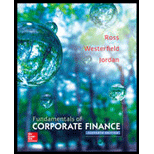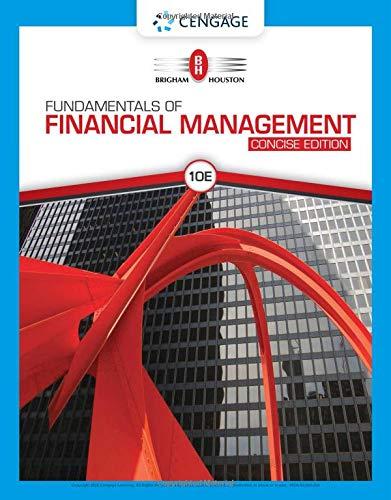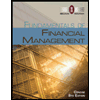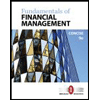
Fundamentals of Corporate Finance
11th Edition
ISBN: 9780077861704
Author: Stephen A. Ross Franco Modigliani Professor of Financial Economics Professor, Randolph W Westerfield Robert R. Dockson Deans Chair in Bus. Admin., Bradford D Jordan Professor
Publisher: McGraw-Hill Education
expand_more
expand_more
format_list_bulleted
Question
Chapter 13, Problem 5M
Summary Introduction
Case summary:
Person J recently joined an investment firm named Company CW. His boss, Person P was taking about the investment portfolio. Person P is concerned about the systematic risks of potential investments. The company wants to analyze one such potential investment namely, Company C.
A vendor provides data about the stocks. However, the vendor does not disclose the method of calculating the data. Person P wants to know the way in which the analysis is made. Hence, he asks Person J to evaluate Company C.
Characters in the case:
- Company CW: Investment firm
- Person P: Founder of Company CW
- Person J: New employee
- Company C: The potential investment
To discuss: The beta calculated by Person J and the beta shown on “finance.yahoo.com”.
Expert Solution & Answer
Want to see the full answer?
Check out a sample textbook solution
Students have asked these similar questions
I need help completing a chart with the following base on Amazon
What is the primary purpose of financial management?
A) Maximizing profits
B) Minimizing costs
C) Maximizing shareholder wealth
D) Managing liquidity need help!
What is the primary purpose of financial management?
A) Maximizing profits
B) Minimizing costs
C) Maximizing shareholder wealth
D) Managing liquidity
Chapter 13 Solutions
Fundamentals of Corporate Finance
Ch. 13.1 - How do we calculate the expected return on a...Ch. 13.1 - In words, how do we calculate the variance of the...Ch. 13.2 - What is a portfolio weight?Ch. 13.2 - How do we calculate the expected return on a...Ch. 13.2 - Is there a simple relationship between the...Ch. 13.3 - What are the two basic parts of a return?Ch. 13.3 - Under what conditions will a companys announcement...Ch. 13.4 - Prob. 13.4ACQCh. 13.4 - Prob. 13.4BCQCh. 13.5 - What happens to the standard deviation of return...
Ch. 13.5 - What is the principle of diversification?Ch. 13.5 - Why is some risk diversifiable? Why is some risk...Ch. 13.5 - Why cant systematic risk be diversified away?Ch. 13.6 - Prob. 13.6ACQCh. 13.6 - What does a beta coefficient measure?Ch. 13.6 - True or false: The expected return on a risky...Ch. 13.6 - How do you calculate a portfolio beta?Ch. 13.7 - Prob. 13.7ACQCh. 13.7 - What is the security market line? Why must all...Ch. 13.7 - Prob. 13.7CCQCh. 13.8 - If an investment has a positive NPV, would it plot...Ch. 13.8 - What is meant by the term cost of capital?Ch. 13 - Prob. 13.1CTFCh. 13 - Prob. 13.5CTFCh. 13 - Beta is a measure of what?Ch. 13 - The slope of the security market line is equal to...Ch. 13 - Where would a negative net present value project...Ch. 13 - Prob. 1CRCTCh. 13 - Prob. 2CRCTCh. 13 - Systematic versus Unsystematic Risk [LO3] Classify...Ch. 13 - Systematic versus Unsystematic Risk [LO3] Indicate...Ch. 13 - Prob. 5CRCTCh. 13 - Diversification [LO2] True or false: The most...Ch. 13 - Portfolio Risk [LO2] If a portfolio has a positive...Ch. 13 - Beta and CAPM[LO4] Is it possible that a risky...Ch. 13 - Corporate Downsizing [LO1] In recent years, it has...Ch. 13 - Earnings and Stock Returns [LO1] As indicated by a...Ch. 13 - Determining Portfolio Weights [LO1] What are the...Ch. 13 - Portfolio Expected Return [LO1] You own a...Ch. 13 - Portfolio Expected Return [LO1] You own a...Ch. 13 - Prob. 4QPCh. 13 - Prob. 5QPCh. 13 - Prob. 6QPCh. 13 - Calculating Returns and Standard Deviations [LO1]...Ch. 13 - Calculating Expected Returns [LO1] A portfolio is...Ch. 13 - Returns and Variances [LO1] Consider the following...Ch. 13 - Returns and Standard Deviations [LO1] Consider the...Ch. 13 - Calculating Portfolio Betas [LO4] You own a stock...Ch. 13 - Calculating Portfolio Betas [LO4] You own a...Ch. 13 - Using CAPM[LO4] A stock has a beta of 1.15, the...Ch. 13 - Using CAPM[LO4] A stock has an expected return of...Ch. 13 - Using CAPM [LO4] A stock has an expected return of...Ch. 13 - Using CAPM [LO4] A stock has an expected return of...Ch. 13 - Using the SML[LO4] Asset W has an expected return...Ch. 13 - Reward-to-Risk Ratios [LO4] Stock Y has a beta of...Ch. 13 - Reward-to-Risk Ratios [LO4] In the previous...Ch. 13 - Using CAPM [LO4] A stock has a beta of 1.14 and an...Ch. 13 - Portfolio Returns [LO2] Using information from the...Ch. 13 - Prob. 22QPCh. 13 - Portfolio Returns and Deviations [LO2] Consider...Ch. 13 - Analyzing a Portfolio [LO2, 4] You want to create...Ch. 13 - Analyzing a Portfolio [LO2, 4] You have 100,000 to...Ch. 13 - Systematic versus Unsystematic Risk [LO3] Consider...Ch. 13 - SML [LO4] Suppose you observe the following...Ch. 13 - SML [LO4] Suppose you observe the following...Ch. 13 - Prob. 1MCh. 13 - Beta is often estimated by linear regression. A...Ch. 13 - Prob. 3MCh. 13 - Prob. 4MCh. 13 - Prob. 5M
Knowledge Booster
Similar questions
- The time value of money concept assumes that: A) A dollar today is worth more than a dollar tomorrow B) A dollar tomorrow is worth more than a dollar today C) Money has no time value D) Money grows at a fixed interest rate need answer.arrow_forwardThe time value of money concept assumes that: A) A dollar today is worth more than a dollar tomorrow B) A dollar tomorrow is worth more than a dollar today C) Money has no time value D) Money grows at a fixed interest ratearrow_forwardWhich option is correct? 19. In financial terms, liquidity refers to: A. Profitability of an investmentB. Ability to meet short-term obligationsC. Long-term solvencyD. Market value of equityarrow_forward
- The following data provides the monthly Comcast cable bill for a random sample of 20 households along with the number of televisions in the household (TV), the number of people living in the household (People), and the number of years that household has been a Comcast customer (Years). Bill TV People Years $56 1 3 8 $59 3 5 11 $67 3 2 3 $75 2 3 8 $76 4 1 8 $82 1 5 4 $84 3 3 3 $84 1 3 8 $84 4 4 4 $90 2 4 3 $91 3 5 5 $100 2 7 9 $100 2 2 5 $102 4 4 6 $104 3 5 10 $104 3 4 6 $112 4 3 2 $114 4 5 8 $130 5 5 1 $135 5 6 7 Develop a regression equation that will predict the monthly Comcast cable bill for a household based on the number of televisions in the household, the number of people living in the household, and the number of years that household has been a Comcast…arrow_forwardcan you provide correct answer for this question? If the Net Present Value (NPV) of a project is positive, it indicates: A. The project is unprofitableB. The project is financially viableC. The project has no riskD. The project will increase costsarrow_forwardI need correct answer for this question! If the Net Present Value (NPV) of a project is positive, it indicates: A. The project is unprofitableB. The project is financially viableC. The project has no riskD. The project will increase costsarrow_forward
- The market where new securities are issued and sold to investors is called: A. Secondary marketB. Money marketC. Primary marketD. Over-the-counter marketarrow_forwardA bond is trading at a premium when: A. Its coupon rate is equal to the yield to maturityB. Its market price is higher than its face valueC. Its market price is lower than its face valueD. It is issued by a well-rated companyarrow_forwardNeed help ! In financial terms, liquidity refers to: A. Profitability of an investmentB. Ability to meet short-term obligationsC. Long-term solvencyD. Market value of equity need answerarrow_forward
- In financial terms, liquidity refers to: A. Profitability of an investmentB. Ability to meet short-term obligationsC. Long-term solvencyD. Market value of equityarrow_forwardNeed help! Which type of risk cannot be eliminated through diversification? A. Market riskB. Credit riskC. Operational riskD. Unsystematic riskarrow_forwardWhich type of risk cannot be eliminated through diversification? A. Market riskB. Credit riskC. Operational riskD. Unsystematic riskarrow_forward
arrow_back_ios
SEE MORE QUESTIONS
arrow_forward_ios
Recommended textbooks for you
 Fundamentals Of Financial Management, Concise Edi...FinanceISBN:9781337902571Author:Eugene F. Brigham, Joel F. HoustonPublisher:Cengage Learning
Fundamentals Of Financial Management, Concise Edi...FinanceISBN:9781337902571Author:Eugene F. Brigham, Joel F. HoustonPublisher:Cengage Learning Fundamentals of Financial Management, Concise Edi...FinanceISBN:9781285065137Author:Eugene F. Brigham, Joel F. HoustonPublisher:Cengage Learning
Fundamentals of Financial Management, Concise Edi...FinanceISBN:9781285065137Author:Eugene F. Brigham, Joel F. HoustonPublisher:Cengage Learning Fundamentals of Financial Management, Concise Edi...FinanceISBN:9781305635937Author:Eugene F. Brigham, Joel F. HoustonPublisher:Cengage Learning
Fundamentals of Financial Management, Concise Edi...FinanceISBN:9781305635937Author:Eugene F. Brigham, Joel F. HoustonPublisher:Cengage Learning- Principles of Accounting Volume 1AccountingISBN:9781947172685Author:OpenStaxPublisher:OpenStax College
 EBK CONTEMPORARY FINANCIAL MANAGEMENTFinanceISBN:9781337514835Author:MOYERPublisher:CENGAGE LEARNING - CONSIGNMENT
EBK CONTEMPORARY FINANCIAL MANAGEMENTFinanceISBN:9781337514835Author:MOYERPublisher:CENGAGE LEARNING - CONSIGNMENT

Fundamentals Of Financial Management, Concise Edi...
Finance
ISBN:9781337902571
Author:Eugene F. Brigham, Joel F. Houston
Publisher:Cengage Learning

Fundamentals of Financial Management, Concise Edi...
Finance
ISBN:9781285065137
Author:Eugene F. Brigham, Joel F. Houston
Publisher:Cengage Learning

Fundamentals of Financial Management, Concise Edi...
Finance
ISBN:9781305635937
Author:Eugene F. Brigham, Joel F. Houston
Publisher:Cengage Learning


Principles of Accounting Volume 1
Accounting
ISBN:9781947172685
Author:OpenStax
Publisher:OpenStax College

EBK CONTEMPORARY FINANCIAL MANAGEMENT
Finance
ISBN:9781337514835
Author:MOYER
Publisher:CENGAGE LEARNING - CONSIGNMENT